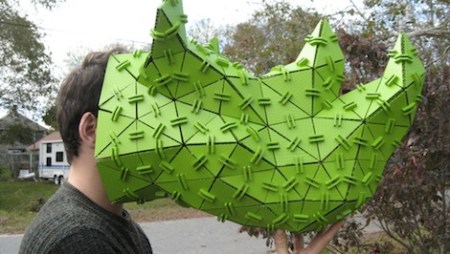
[Paul] a.k.a. [VoidFraction] put up the source and documentation for his sculptures made with laser cut polygons.
For computing his triangles, [Paul] developed LcAgl, an algorithm that transforms a 3D model into the AutoCAD file needed to cut a whole bunch of triangles and connectors. This file was shot over to a laser cutter and after a confusing assembly, [Paul] can make just about any low polygon count model he wants.
For his sculptures, [Paul] uses Coroplast, a type of corrugated plastic commonly used in political campaign signs. Coroplast is lightweight and flexible, a bonus when [Paul] is fitting his triangles together. The connecting tabs are made from acrylic – a very rigid material, so the triangles are held tightly in place.
Since the models in most 3D games are just a bunch of polygons anyway, this technique reminds us of the first 3D console games. [Paul]’s rhino looks like it walked off the set of a low polygon game like Virtua Fighter or Jumping Flash!.















Why confusing? Figure out an order to put the pieces together in, and engrave a number on each edge. Go sequentially, find matching numbers, hey, you just mixed the jigsaw and the dot-to-dot!
You could also tab the parts and break them apart only when you are ready to put them together.
Exactly, our laser cutter supports vector etching as well as cutting. When the connectors and faces are generated, its complete with laser-etched tags for assembly
This would be great for comic-cons…make yourself look just like your favorite 16-bit character…but held together by plastic strips.
Now which 16 bit system was known for its 3D polygons?
I suppose you might argue that the 32X was 32bit, but it was really just a genesis add-on…and it had the best version of Virtua Fighter ever made.
Genesis had Vectorman!
Never played a 3D SNES game? Starfox, Stunt FX Racing?
I’ve certainly played 3D SNES games, and thought about that before posting. However, the system itself could not handle polygons. The cartridges for those special games had a small ~25mhz RISC cpu called the SuperFX that handled the 3D.
Combine this with OGLE and start making pretty much anything from any modern game (World of Warcraft anyone?)
OGLE?
And, papercrafters are way ahead of you: http://wowpapercraft.blogspot.com/
Needs to be able to handle quads not just poly meshes.
Also – Minecraft.
Quads are not difficult. I imagine you forget the fact that Quads are actually built from pairs of tris?
This is awesome,
I was waiting for just this invention.
I make props and I love the way this will enable me to build new things.
Not just props but also buildings backdrops and structures.
I would like to applaud the maker and thank him wholeheartly for his work and even moreso for sharing it with the world :D
Maybe I’m missing something, but wouldn’t it make a lot more sense to have the connectors *inside* the sculpture?
Sure, if you happen to manage to invent a laser cutter that is able to do such a thing. This process is limited by the flat geometry a laser cutter can produce. Which is why you see the connectors.
I don’t get it, why can’t you put the tags on the inside? I think the connectors don’t need to be shaped otherwise.
I would guess those connectors are H shaped, showing on both the inside AND the outside.
Check out his website, other projects do have the connectors on the inside.
http://www.flickr.com/photos/61463511@N08/5635247107/in/set-72157626447769584
I have to agree with everyone shouting “StarFox”
I looked at the polygon acrylic and I thought “hey someone at my school is doing the same thing!” then I find out it IS someone at WPI…
COOL.